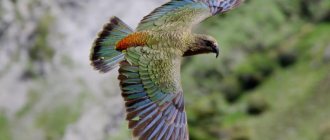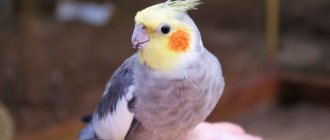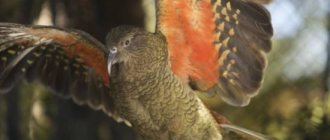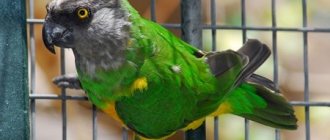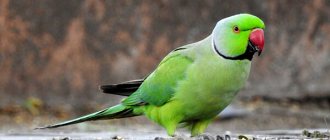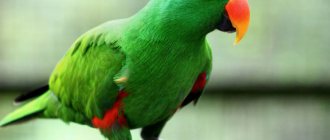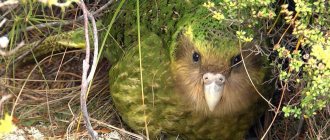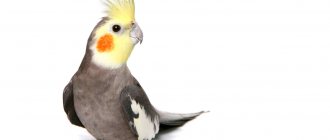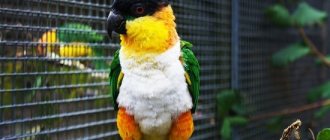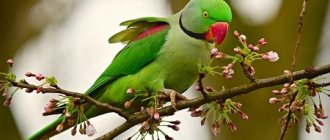Today, the Corella parrot ranks after the budgerigar on the list of recognizable exotic birds. Nymph parrots, as they are also called, can change until the first year, only after this stage you will see how the appearance of the pets changes. And according to reviews from the owners: it is impossible to know everything about cockatiels! After all, they are funny, funny and dancing favorites, with whom it is never boring to sing!
Features of keeping cockatiels
Cockatiels are one of the noisiest creatures in the bird world.
Before you get a new pet, you should decide whether it is suitable for you and your family. Still, the character traits of this species will be a plus for some, but will irritate others.
Be sure to take this into account before purchasing a cockatiel so as not to create additional stress for yourself or the bird.
- 1. Cockatiels are noisy and active. If you don’t yet know whether the cockatiel parrot talks or not, then rest assured that with proper training, it will talk, and how. No, they won't broadcast incessantly, but get ready for morning singing and evening lullabies. Not all people tolerate sharp sounds well at this time of day.
- 2. They love family attention and do not tolerate prolonged loneliness. If you have a very busy schedule and are away from home most of the time, then this pet is not for you. Some birds require less attention, but their level of socialization will drop significantly.
- 3. There will be quite a lot of debris from the nymph. The bird has its own home, and it will definitely establish its own order there, and throw everything unnecessary outside the cage. Of course, feathers will fall out and fly in all directions. During free walks, the cockatiel may well find something and chew something.
- 4. Buying a bird is not the last financial investment. She will also need a cage with all the accessories, regular purchase of food, special toys and broken items in the cage, periodic examinations by a veterinarian and even treatment. The Corella will be a full member of the family and will require the necessary care in all aspects.
- 5. You also need to know how long a cockatiel lives at home. With a good standard of living, this pet will live for more than 20 years and will need care for all these years! Understand that this is not a toy for a few years, the parrot will be with you for a really long time. Corella may well witness how you finish your studies, find your soul mate and your children together graduate from school.
If none of this scares you away, then soon you will have a wonderful, very cheerful and incredibly loyal pet. He will happily greet you, wake you up in the morning and sit on your finger. All that remains is to prepare his future home.
Corella sings "My Neighbor Totoro"
Spreading
Australia is named as the birthplace of the nymph breed. They live in grassy areas with trees and shrubs spaced apart from each other. Parrots were found on plains along river banks and semi-deserts. They like to move in small groups of 20-50 birds, if not during the breeding season. In regions of severe drought, they accumulate in large flocks near water bodies at a safe distance.
Despite free breeding in captivity and easy adaptation to the human environment, Australian legislation prohibits the export of the Corella breed outside the country. However, there are also tame parrots; they adapt well to an unusual place and, under proper conditions, live from 15 to 25 years.
What types of cockatiels are there?
The natural color of these parrots is represented by a gray body, yellow head and bright orange cheeks. During artificial breeding, new, brighter colors were developed. Now you can find cockatiels with the following colors from breeders:
- White. There are two types: albino and just white. Differences in eye color. Albinos will have red eyes, while whites will have black eyes. Let's allow a light cream shade of plumage. The head and crest remain yellow.
- Whitewing. This color is characterized by white flight feathers, and the main feathers remain gray.
- Light grey. Somewhat lighter than usual gray individuals. The yellow head and crest are preserved.
- Pearl grey. In this color the feather has uneven pigmentation. The very edge is a rich gray color, and the middle of the feather is white. You can find individuals that have a cinnamon or yellow tint instead of white. Only females retain this unusual coloration for their entire lives. Males change color after molting.
- Cinnamon. The main plumage can take on various shades of brown.
- Dark yellow. In this case, the color varies from light cream to dark yellow.
- Lyutino. This color implies a yellow body color with white spots on the wings. The cheeks are bright orange.
- Blackwing. Representatives of this color have a back and tail that are much darker than the main gray color of the body. The wings are also darker and have white spots.
- Black. The entire cockatiel is a rich dark gray color. The breast is almost black in color; there are light spots on the wings. The cheeks are dark orange and may have a few black feathers.
The most common colors: gray and lutino - Sheki or spotted. The main shade of these representatives is gray. There are many white spots on the wings. The head is white, the tail should be white-yellow. Spotted cockatiels have a subspecies - the harlequin. In such birds, only the wings remain gray, the head and crest are yellow, and the main part of the feathers is white.
By crossing different colors of cockatiels, unusual and original colors are increasingly being obtained. But most of them are still gray. This coloring is considered natural. The brightest colors are obtained by crossing spotted representatives with other pigment carriers.
Appearance
In appearance, the nymph parrot belongs to the subgroup of flat-tailed birds. The rounded beak is very active and large, unlike other representatives of birds. The four-toed paws are usually directed in different directions. This natural characteristic is required for dexterous movement along tree branches and convenient capture of food. A special feature is the elongated shape of the plumage on the back of the head.
What should be in a cockatiel's cage for feeding and caring for them?
Caring for a cockatiel at home largely depends on its cage. It must be of sufficient size. Choose a cage that is at least 60 centimeters high and 50 centimeters wide. It is advisable that the rods be positioned horizontally or have several horizontal rods - the bird loves to climb, but it will not be comfortable for it on vertical ones. The size of the gap between the rods is recommended to be 1.9 centimeters, and the rod itself should be steel. Lead and zinc rods spoil the health of all birds due to the poisons they release.
The conditions for keeping cockatiels additionally require special equipment. Must be present:
- Drinker and 2 feeders. One of them will be for dry grain mixtures, and the second for fresh food and wet food;
- Several perches;
- Rocker;
- Nest or house;
- Special toys. These can be ropes, rope, plastic or wooden ladders, special balls and a mirror.
Additionally, you can install a special screen on the cage so that the food does not spill out of the cage when the nymph eats. It is useful to have special cleaning products in your arsenal. With them, cleaning the cage will be much easier, and in addition, such products are also good disinfectants.
Lifestyle
Mostly Corella parrots live in areas such as forests and eucalyptus groves, which are located along the banks of rivers, and in savannas with overgrown grounded bushes. In the wild, they are not used to hiding in the crowns of trees, sitting on the tops. They show different attitudes towards people, depending on where they are: they are afraid in the grass, but in the atmosphere they are used to (at the tops of trees) they are more docile. The birds' habits are more family-like and calm.
Outside their territory, parrots are very careful and circumspect. They do not stay on the banks of reservoirs and rivers longer than expected; to satisfy their thirst, they descend vertically to clean water, after drinking, they return home. Birds' favorite food is the seeds of herbaceous and woody plants, sometimes wheat seeds.
Drowsiness in males and females occurs both at night and during the day. Interesting facts about their regime are explained by the hot climate, where food is most likely obtained more easily at dawn and in the evening. They do not sleep soundly, and despite the small ears of the parrot, they hear the most insignificant rustles. The male sleeps less than the female due to protection of the offspring. Because of this, the male's beak is much stronger.
Choosing a pet
To keep your pet healthy and happy, keep his house clean.
When we have a ready-made home for the cockatiel, we can choose a bird for ourselves. Where to choose it is your personal preference. It is more reliable to contact breeders who breed this particular breed of birds. From them you can learn all the nuances of keeping them at home, clarify what the bird does not like, create a balanced diet and look at the parents. Moreover, you will not need to be tormented by questions about how to determine the gender of your nymph. The breeder will definitely answer this question, because he knows from his own experience how to care for a cockatiel at home.
Obvious sexual characteristics in cockatiels appear from 3.5 months, but one can definitely say only after a year. How to distinguish a male cockatiel from a female from a photo is quite possible. The male is usually brighter in color than the female. There are also differences in the crest. The female has a wider and shorter crest, but the boy will have longer feathers, and the crest itself will be narrower. There are also differences in behavior. Males are more active, more sociable and love to sing. Girls are not so talkative. When boys sit, they rise high on their paws, while girls' bellies are almost at the same level as their paws.
The best age for cockatiels to move to a new family is 3-3.5 months. The chicks are old enough to be separated from their parents and young enough to undergo socialization with a new family. You can find out your approximate age yourself. The peculiarity of each growth period is reflected in the color of the plumage, the color of the eyes, paws, folds on the paws and the smoothness of the beak.
Young cockatiels are somewhat brighter and lighter in color, while adults are richer and darker. The crest of juveniles is not as thick as that of mature individuals. The eyes of young animals are almost black, and with age the iris becomes lighter. The beak and feet of young birds are pinkish-gray, and the older the nymph gets, the less pink and more gray appears on the beak and feet . The smoothness of the beak also indicates age. In very young birds it is smooth, but years of life make it rough.
Special attention should be paid to:
- Plumage quality. It is not worth purchasing a chick during the molting period, because the body is already under stress, and moving can seriously harm your health. Their first moult occurs between six months and 8 months. The feather should lie one to one, without bald spots or stickiness.
- Eyes. They should be round, in no case squinted. There should be no discharge or peeling on them. Pay attention to the shine in the eyes.
- Beak condition. It should not be deformed or injured, and not have any growths. The nostrils should be dry and free of any discharge.
- Paws. Nymphs have 4 toes on their paws. 2 “look” forward and 2 look back. The claws should be smooth and neat.
- Cloaca. It should be clean, just like the tail. Residues of feces on the cloaca and tail are a clear signal that the cockatiel is unhealthy.
Monitor the health of the bird.
In any case, the choice of a pet should be independent, because you are choosing a friend for a very long period of time. It is better to transport a parrot in a special bird carrier. When the nymph is at home, carefully transplant it into the main cage and do not touch it at all for a while.
Tips for buying a parrot
When choosing a parrot in a nursery or elsewhere, the sex of the bird can be determined by its color and behavior. As a rule, before 1 year of life, it is very difficult to do this without being a specialist. In this case, it is necessary to take into account that males are noisier, often knock with their beaks, and also make more complex sounds.
Where to buy and what to look for
The Corella parrot can be purchased both in a nursery and from a private breeder. If the parrot is healthy, it has a beautiful and neat appearance, with even plumage that fits tightly to the body, clear eyes and an excellent appetite. The bird is quite active and “verbose”.
If a parrot nervously rushes around in the cage, screams loudly, scratches itself or pulls out feathers, then this is the first sign that something is wrong with the parrot and you should absolutely not buy it. You cannot buy very apathetic individuals, depressed, ruffled, losing coordination or falling over on their side.
Corella parrot price
Australia is considered the homeland of Corella parrots and their export from the country is prohibited by law, so only birds artificially bred in nurseries or from private breeders are sold. The cost of a parrot is not exorbitant, but quite affordable, due to the simple breeding process. For a parrot, 3 months old, you will have to pay an average of 3 thousand rubles.
Adaptation to a new place
The place must be fully prepared at the time of move-in. You should not pull your cockatiel out of its carrier with your hands into its new home. Create a hallway by simply opening the carrier door and cage and placing them opposite each other. The bird must move from one place to another on its own.
It will take time to get used to your new home. This will take at least a day, and may take a week. The owner should under no circumstances disturb the parrot at this time. A new environment already frightens the animal, and excessive attention will only aggravate the cockatiel’s stressful state. After adapting to the place, you can establish contact with your pet.
Cleaning the cage
Corella parrots are very active and playful, they love to climb rods and perches. They need fairly spacious houses. To keep one bird, you must purchase a horizontal cage, the dimensions of which are at least 50x50x65 cm.
The bird's home and all the equipment in it must be cleaned periodically to prevent fungi or mold from appearing in it. It is recommended to do this twice a week, with warm water. It is necessary to remove food debris and droppings. The tray can be filled with fine sand or covered with paper.
Taming the cockatiel
Usually taming does not require anything special or complex skills. If the bird was purchased from a breeder, then it is socialized from the beginning. Individuals from pet stores may be a little less attuned to humans, but this can also be resolved within a few weeks.
At first, just stay next to the nymph's cage for 20-30 minutes a day and talk to her . Increase your communication time every day. If there is no negative reaction and the bird approaches you, give it a treat through the cage. After a few days, open the cage and stick a tasty treat nearby so that the nymph becomes interested and comes up to take it. Then place the treat on your open palm so that the bird climbs onto your hand. When the cockatiel climbs onto your hand without fear, turn your hand so that it is comfortable for her to sit on your finger and pull the parrot out of the cage. This is how you can start taming your parrot.
Now you can pet and “sniff” your pet. You don’t have to worry about what cockatiels love. They love affection, attention and treats very much. The Corella parrot is not particularly demanding in terms of care, maintenance and feeding. But he is very demanding in communicating with his new family. She will need at least an hour of your attention every day in order not to lose the level of socialization.
You can teach a cockatiel to sing beautiful melodies
These birds are very good at learning various tricks and human speech. Males do most of the talking, whistling and singing. Girls are more modest and silent, but a lot depends on how often you talk to her. Any animal is set up for dialogue, and the more you talk to it, the more it will want to answer you.
The basis of proper training is praise and affection. Never swear at a bird. This will only scare her, but she will not understand what exactly upset you. Repeat the desired words or tricks systematically for 20-30 minutes a day. Immediately positively encourage any fulfilled desire - praise with words, stroke, give a treat.
When practicing commands, always accompany the action with one specific word. Let’s say, when learning to sit on a finger, say “sit,” move your finger under the paws (this is how the cockatiel will reflexively move its paws to the finger) and immediately give it a treat.
Emotional impact
Being sociable birds, parrots require attention from their owners. You need to communicate with them regularly, talk, play. Otherwise, they may become depressed or aggressive.
For a bird to develop fully, it needs free flights. Corellas love to walk on the floor and sit with people on the sofa or armchair. When moving around the house, you need to be careful not to accidentally harm your pet.
Nutrition
Grains must be present in the parrot’s diet.
It is a balanced diet that will be the main guarantee of the excellent health of the nymphs and their life expectancy. The ideal option would be a ready-made grain mixture for cockatiels and similar parrots. Don't be alarmed that they contain a lot of grass, grains or other granules. They should be the basis (at least 65%) of nutrition.
If the main food consists of whole grains, this can cause complications on the liver. All grain feed contains too much fat, which can undermine the health of the bird. Additionally, the diet should contain fresh fruit or vegetables, cooked beans, sprouted grains - these are natural sources of trace elements, water and minerals. Be sure to install a special chalk in the cage, it will be a source of calcium. It is especially necessary for females.
There is a list of prohibited foods for cockatiels:
- Almost all heat-processed foods.
- Any sweet, spicy or fatty food.
- Mushrooms.
- Raw legumes.
- Onion.
- Avocado.
- Mango.
- Persimmon.
- Papaya.
- Bird cherry.
- Foliage from tomatoes.
- Chocolate.
- Alcohol-containing products.
- Caffeine-containing products.
Change the water daily, as this is what most often provokes diseases in cockatiels. It often contains leftover food or droppings, which are sources of proliferation of viral and fungal cultures. Remove all raw food after 3-4 hours and throw it away, even if the bird has not eaten. Such products spoil very quickly and become moldy. You should not give more than one slice of any fruit or vegetable.
Cockatiels eat heat-treated vegetables. The daily portion for one bird of all types of food is
40 grams. The only thing not included is greens, which can be enjoyed in any quantity. These are the greens that are familiar to us, such as parsley, celery, dill, lettuce and spinach, as well as sprouted grains, dandelion foliage, tree buds, clover, and nettles. Wood sticks are necessary and loved by cockatiels. These can be fruit trees, birch, pine, linden, spruce.
Introduce each new product gradually. You should not overwhelm your bird with unfamiliar foods. Firstly, this can give a negative reaction from the gastrointestinal tract (loose stools), and secondly, the pet may completely refuse unfamiliar food.
Natural shades of feathers
Natural plumage colors are required for Corellas to camouflage in their natural environment. Therefore, birds living in freedom are carriers of a simple color. In most cases, gray predominates with a yellow crest on the head and orange dots on the cheeks. Some have subtle yellow or white feather tips on their heads.
The wings are brown. The bellies are light gray in color. There are red-cheeked (with red cheeks) and rosy-cheeked (with pink cheeks) Corellas. Albinos are often found in nature.
Natural feather color of a parrot
Features of caring for a cockatiel
Corellas are not very demanding when it comes to keeping them. It is important that they do not have dirt, have enough light and always have entertainment. Clean the cage regularly, and if you use bedding, choose only natural fillers. Sawdust is best.
Illumination and daylight hours are important. Don't place the cage in a dark corner, but don't place it close to a window either. Direct sunlight is undesirable. Daylight hours are 10-12 hours. It can be corrected by partially covering the cage in the summer, and by providing additional lighting with lamps in the winter. Too long a day can make the bird more aggressive, and too short a day can make it more apathetic.
Nymphs are contraindicated in drafts and sudden temperature changes. The temperature should always be between 20-25 °C. Birds need bathing in water at a temperature of 30-35 °C. These can be baths, or just a game when water flows from the tap. Cockatiels love baths.
There are no particular differences between the care of boys and girls. Differences may be present in nutrition, since even single females often lay eggs, they need additional calcium. Females also need a house or an imitation nest for comfort, but these objects will provoke the laying of empty eggs.
History of discovery
Cockatiels are native to Australia. In 1838-1840 the famous ornithologist and animalist John Gould visited this country with a zoological expedition and took from there about 800 birds, among which was the Nymph. The scientist wrote and published the book “Birds of Australia”, where he gave a complete description of their appearance and way of life.
In the forties, cockatiels spread throughout Europe. The fact that they are now present in our lives is the merit of the breeders. In the sixties of the last century, the Australian leadership banned the export of parrots outside the state. After this, selection and breeding of Corellas proceeded without the participation of wild winged birds.
Health
In general, this breed is not prone to diseases and is long-lived. Any diseases that occur in cockatiels are the result of neglect of the pet. Be attentive to the behavior of the bird, because it will not be able to tell you that it is not feeling well.
What health problems may exist:
- Feather loss.
- Feather and skin parasites.
- Violation of the structure of bones and beak.
- Infectious diseases.
- Disturbances in the gastrointestinal tract.
- Obesity.
- Amyotrophy.
- Avitaminosis.
Sound the alarm immediately and run to the clinic if the bird is already clearly sick. Most diseases are caused by poor or inappropriate nutrition and stress. Signs of health problems can be seen in behavior. The cockatiel becomes more aggressive, more active, or, on the contrary, very lethargic and constantly sleepy.
The pet may refuse any food or liquid. Check for breathing problems and any discharge from the nose, eyes or cloaca. Never treat a cockatiel yourself! Entrust examination and treatment only to a specialist!
Female and male
The photo shows a female and a male cockatiel.
Sexual dimorphism in cockatiels is weakly expressed. The male Corella is colored in richer shades and has distinctive white stripes on its wings. The plainness of the female’s coloring can only be noticed in comparison with an individual of the opposite sex. She also has transverse pale yellow stripes on her tail, and oval spots of the same color can be found on the inner surface of her wings. Young individuals retain the same color as their mother until the completion of the juvenile molt. However, after molting at 9-12 months, it changes in males.
In cockatiel chicks, sex can only be determined by behavioral reactions. Adolescent males sing loudly, bang their beaks on hard surfaces, straighten their shoulders and stomp, trying to attract the attention of females. Those, in turn, behave modestly, take a low posture and throw back their heads, showing their readiness to submit to the male.
Cockatiel breeding
At home, breeding of Corella parrots takes place without any problems or difficulties. It is not recommended to have chicks for individuals under one and a half years old, although females are capable of laying eggs as early as 8 months. At such a young age, the girl will only undermine her health with stress, and will not be able to fully hatch the chicks.
cockatiel egg
Attempts to have offspring will not always be successful. The egg may be unfertilized or stop developing at some stage. This happens and you should panic. Often not all eggs are fertilized, but they do not need to be removed from the nest - they help maintain the necessary warmth.
During the mating season itself and after laying eggs, it is very important to strengthen the diet with calcium and “fresh” vitamins. The expectant mother begins to have a serious calcium deficiency and needs to replenish it. The cockatiels will hatch and care for the chicks together. The chicks hatch in 2.5-3 weeks.
When the babies appear, there should be a lot of wet food in the feeder so that the parents are able to feed the young . The chicks are developing rapidly and in a little more than a month they will already be completely independent. However, you can say goodbye to them only at the age of 3.5 months.
Video: what you need to know before getting a cockatiel
Owner reviews
Corella parrots are very popular among our lovers of domestic ornamental birds. The fact is that a parrot is easily tamed, and can also easily learn both individual words and entire phrases. But at the same time, it should be noted that the bird’s ability to reproduce various sounds that are not typical for a parrot is quite limited.
Important to remember! The Corella parrot should never be teased, as when angry it makes very unpleasant sounds, and quite loud ones at that.
For the sake of fairness, it should be noted that the parrot makes mostly monotonous and very annoying sounds, sometimes grating on the ears. Males sing well, imitating various sounds, as well as the singing of other birds, such as a nightingale or titmouse. Many owners claim that the parrot simply begs for pieces of food from the table and is able to open the lock on the cage when no one is home.
Disadvantages of KEEPING A Cockatiel Parrot. Are you ready for this?
Lifespan
Keeping a cockatiel at home allows you to delay its death, compared to living freely in nature. Tame parrots of this species live on average 16-18 years if they are properly cared for. You can read more about the life expectancy of cockatiels in the article “How many years do cockatiels live?”
Diseases
Housing conditions are of great importance for the health of the cockatiel. Parrots of this species do not get sick so often, and you can suspect something is wrong based on the pet’s changed appearance and behavior. A sick bird does not react to stimuli, sits with its eyes closed, ruffled, and does not eat anything. You need to take your feathered friend in your hands and carefully examine the plumage, the shade of the wax, and feel the crop. Possible reasons for the bad condition of the cockatiel:
- parasites;
- intestinal disorder;
- goiter infections;
- eye inflammation;
- poisoning;
- cold.
If you cannot independently determine the parrot’s illness, you need to show it to a veterinarian, and then create the necessary conditions for the pet’s speedy recovery.
